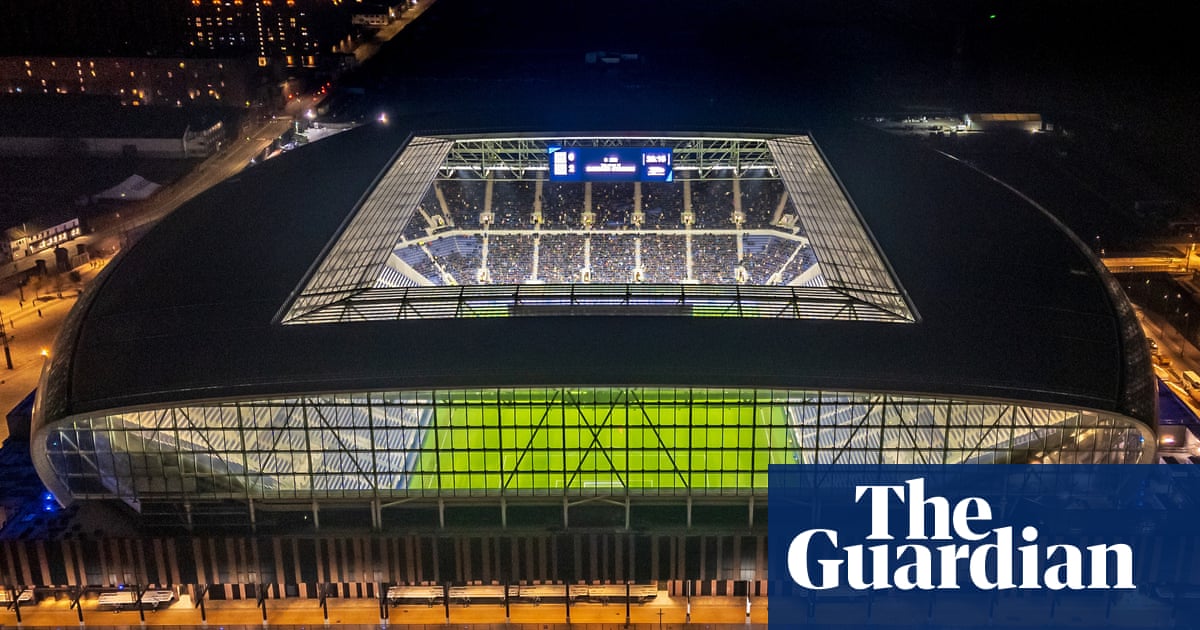“Nil satis nisi optimum,” boasts the motto of Everton FC: “Nothing however the perfect is sweet sufficient.” Performances on the pitch over the previous few seasons have prompt in any other case (what’s Latin for “Something to remain up will do?”) however within the type of the glowing new stadium at Bramley-Moore Dock, which is able to exchange Goodison Park as Everton’s everlasting house from the beginning of subsequent season, the membership now has tangible proof that its historic aspiration to excellence is ultimately being met.
Based mostly on the renderings and early footage of its inside, Everton Stadium (will probably be some time earlier than that bland placeholder is draped within the capitalist rococo of the “TeslaDome” or “Open AI’s ChatGPT Area” or “Palantir Presents Bramley-Moore Dock”) seems to be a pleasingly raked and compact enviornment that ought to retain not less than among the raucousness of Everton’s outdated house. The stands are on the steepest pitch that laws will permit, sightlines are unobstructed from each seat, and judging from the promotional movies, followers won’t ever be greater than 50 metres from both a bathroom or a scouse pie, which looks like a key metric of success for any stadium in Liverpool.
Among the many new construction’s most hyped options is the South Stand, a single stand working from pitch to roof that may accommodate 14,000 followers and turn out to be, within the membership’s personal phrases, a “blue wall” and the “beating coronary heart” of Everton’s house help.
The story in Liverpool, wherein the hope of city renewal rises within the shadow of a brand new sporting landmark, is being repeated throughout a lot of the wealthy world. From Milan to Miami, these are increase instances for brand new stadium development in Europe and the US. However why does the entire infrastructural bonanza really feel so empty?
Everton Stadium’s “blue wall” is, after all, a nod to Borussia Dortmund’s well-known “yellow wall” at Westfalenstadion, which now has a very good declare to being essentially the most extensively imitated stadium characteristic on the planet. Each group constructing a stadium as we speak desires a steep house finish to host essentially the most passionate followers and provide shade and noise to the matchday expertise: Tottenham Hotspur Stadium’s 17,500-seat South Stand was designed to create a “wall of sound” (or maybe of fury, given the latest route of the membership), whereas within the US the Buffalo Payments are constructing a brand new 60,000-seater whose northern finish zone will put followers as shut as 12ft away from the on-field motion and amplify house benefit, the architects declare, “by means of an intimidating wall of help.” The group homeowners and lots of followers need them; the cities assume they want them. However who really advantages when the massive tops go up?
Spectacular constructions although they might be, these new arenas all have a sameyness to them, even within the aesthetic claims that stadium designers now make about their creations’ sensitivity to architectural heritage. Each Everton Stadium and the Payments’ new enviornment, for example, characteristic purple brick bases that “nod” to the commercial historical past of their surrounding cities – reworking, for the denizens of those proud outdated manufacturing facilities, the ache of deindustrialization into the costly pleasure of participation within the twenty first century leisure financial system.
Traditionally, the structural quirks and infelicities of stadiums – their harshness, publicity, sparse and probably life-threatening meals choices, and barbarically lengthy rest room traces – supplied a type of gas to fan tradition. Are we touring in direction of a world of blandly good stadium engineering, the place each stadium appears and feels the identical, and each fanbase is funneled in direction of the identical set of game-day habits and enthusiasms?
Given how small the circle that dominates the design of top-level stadiums is, the drift to homogenization could also be no shock. A lot of the high-profile stadiums constructed in recent times are the work of a handful of companies together with Populous, which constructed the brand new arenas for each Spurs and the Payments and was liable for the 2000s-era “retro” craze in baseball stadium design. Manica was liable for Allegiant Stadium in Las Vegas, the Tennessee Titans’ new house floor in Nashville, and the location-pending new stadium for the Chicago Bears. Foster + Companions designed Lusail Stadium in Qatar and was not too long ago enlisted by Sir Jim Ratcliffe to design the yurt metropolis that may ultimately exchange Outdated Trafford. Dan Meis is behind the brand new bowls for Everton and Roma. Regardless of the particularities of every website and membership, there’s a formulation to those stadiums now, and it’s making the gameday expertise indistinguishable from Doha to Dallas.
Throughout Europe and the US, stadiums have turn out to be the nice hope of city regeneration – the prize asset that may, native officers hope, carry life and a refund to stagnating cities. Superficially this looks like an ideal marriage: prime golf equipment want the elevated income that larger, extra subtle stadiums with richer services will carry, and cities want the enhance to financial exercise that ought to in concept comply with from the development of a significant new venue. It’s true, after all, that in skilled sport’s new world, income is king. For a soccer membership in Europe to maneuver, say, from a cramped and under-serviced 30,000-seater to a modern new enviornment with room for 60,000 folks and all the opposite assorted nonsense represents an enormous step up in financial energy, with the safety to lock in chunky income streams for many years to return. In England, the financial incentives for stadium development are much more highly effective on condition that infrastructure bills are exempt from the Premier League’s new profitability guidelines: for prime golf equipment, constructing huge has turn out to be one thing akin to a monetary free kick.
However nonetheless a lot financial sense they might make, not less than in concept, new stadiums not often (in all probability by no means) entice the identical kind of affection from followers commanded by the ramshackle, lived-in outdated grounds of group lore. As Arsenal’s expertise of the previous twenty years exhibits, the monetary carry of a brand new enviornment typically comes with a much more damaging psychological and cultural drain. Nor do the economics at all times work out. In some instances these stadiums can turn out to be a probably deadly albatross, not solely as a result of servicing the debt that’s usually incurred to construct them is prohibitive but in addition as a result of they often spur overreach. Lyon, for example, moved in to Groupama Stadium in 2016, however satisfying the repayments on their razzmatazz new 59,000-seat, Populous-designed house, amid broader Covid-authored monetary misery and poor participant recruitment, has turn out to be so burdensome that the membership is now sinking in debt and getting ready to administrative relegation to France’s second tier.
A easy answer to the issue of fee, after all, is to get another person to maintain it. That is the monetary reduction line that franchises within the US have turn out to be significantly adept at tapping, with federal regulation permitting native governments to concern tax-exempt bonds to construct sports activities services.
The heavy reliance on public cash to fund development prices within the US is partly a product of necessity. It’s placing how rather more costly it now’s to construct a contemporary 60,000-seater in America than it’s in Europe, the symptom of a broader infrastructural blockage that has turn out to be the main target of a lot latest writing: whereas Tottenham Hotspur Stadium, for example, got here in properly over finances at £1.2bn ($1.5bn), the Chicago Bears’ new colosseum, which is projected to be across the identical dimension as Spurs’ house floor, has been budgeted at a price of $3.2bn. Public contributions for the brand new Titans and Payments grounds characterize the 2 largest stadium subsidies in US historical past.
The motivations that drive governments, not solely within the US but in addition in Europe, to supply monetary and political help to those tasks are a mixture of self-importance (the status and magnetism of an architectural marvel), worry (the specter of defection by the house group to a special location, which is particularly highly effective within the US, with its lengthy historical past of team-to-city betrayal and seduction), and ambition. Of those, it’s ambition that will get all of the headlines; all through the planning approval, development, and unveiling of each new stadium there may be fixed rhetoric about all the great the stadium is doing and can do to revitalize, regenerate, and reboot the encircling financial system. Simply the opposite day Everton’s homeowners have been on the telephone to the UK authorities, asking for more cash on the premise that the membership’s new floor “will speed up Liverpool’s regeneration”, because the headline within the Monetary Instances put it. From taxes to regulation and even rates of interest, the danger of capital flight is the nice menace hanging over fashionable financial coverage. Stadiums literalize this drama in placing, if not at all times apparent, methods, providing native governments a helpful visible metaphor to fulfill themselves they’re doing their bit to inject life into the native financial system and entice outdoors funding whereas tying vital cultural property in place.
There’s one small drawback with the city regeneration argument: it doesn’t maintain up in opposition to the proof. Stadium-led revitalization is the parable that may survive the apocalypse. New stadiums, as an unlimited physique of educational literature exhibits, carry few of the financial advantages that builders, group homeowners, and native politicians promise. No matter stimulus they provide to financial exercise of their rapid neighborhood is invariably offset by a corresponding melancholy in spending and funding in different areas of the identical metropolis.
New stadiums facilitate a switch of wealth, inside geographies and throughout lessons. In lots of instances they might do extra hurt than good, saddling native communities with the prices of development and diverting public funds from schooling and housing whereas siphoning off all of the stadium’s future wealth for the group itself, which principally means the group homeowners: a traditional case of privatizing the earnings whereas socializing the dangers. Constructing new stadiums is nice enterprise for stadium architects, builders, services companies, and group traders, and a awful deal for everybody else. The monetary flows concerned – from the area people into the pockets of group homeowners – are as predictable because the designs of the stadiums themselves.
Even the place public subsidies are modest the monetary results of latest development ripple out to supporters by way of greater ticket costs and dearer facilities; ultimately a day on the stadium turns into an occasional luxurious relatively than a daily pleasure. Custom, neighborhood, rootedness are, we’re at all times advised, on the coronary heart of any new stadium mission, however inevitably they turn out to be diluted as soon as the contemporary concrete stands are crammed. New stadiums don’t simply remodel the bodily actuality wherein a group performs; they modify the group’s fan base too, and the tradition hooked up to it. And maybe that’s the true level inherent within the uniformity of recent stadium design: to eradicate the gnarly, unruly, troublesome, and – let’s be trustworthy – poor supporters, to kick out the kooks and the crazies, and exchange all of them with docile, obedient shoppers prepared to face, sing, and spend on cue.
The arrival of a brand new stadium heralds, in some ways, the start of a brand new membership, unburdened by no matter has come earlier than.
From a distance Everton’s new 52,000-seat house, a metal and glass bubble plopped on prime of a sturdy brick base, has the facet of an enormous escape pod prepared for launch. The extra buffed, dazzling, screen-stuffed and hyperactive these new stadiums seem, the extra they appear to embody not reinvestment within the communities they characterize however liftoff from them.
This text was amended on 29 April 2025 to right the identify of the architect behind the Everton and Roma stadiums.




















